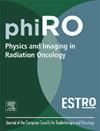A magnetic resonance imaging radiomics approach predicts hepatocellular carcinoma response to stereotactic body radiation therapy
IF 3.3
Q2 ONCOLOGY
引用次数: 0
Abstract
Background and purpose
Predicting hepatocellular carcinoma (HCC) response to Stereotactic Body Radiation Therapy (SBRT) can be challenging. Here, we assessed the value of a radiomics-based machine learning (ML) approach for predicting HCC response to SBRT, using pre-treatment and early post-treatment magnetic resonance imaging (MRI).
Materials and Methods
This retrospective single-center study included 87 patients (M 67, mean age 65.3 ± 9.1y) with HCC treated with SBRT who underwent gadoxetate MRI both pre- and early post-treatment (around 9.5 weeks). Tumor radiomics features were extracted on pre- and post-SBRT MRIs on pre- and post-contrast T1-weighted imaging (T1WI) [pre-contrast, arterial phase (AP), portal venous phase (PVP), transitional phase and hepatobiliary phase]. Long term response was assessed using modified RECIST criteria. Different ML models were developed based on 1st and 2nd order radiomics features to predict long-term objective response (partial and complete response) versus no response (stable and progressive disease). The cohort was randomly divided into training/validation (70 %) and testing 30 %.
Results
A total of 87 tumors were assessed (mean size 2.7 ± 1.6 cm). Objective long-term response was observed in 43 (49.4 %) patients. The best predictive outcomes were achieved using models combining pre- and early post-treatment radiomics, with top performing model combining pre-treatment T1WI-pre-contrast, pre-treatment T1WI-AP and post-treatment T1WI-PVP, achieving an AUC of 0.85 [95 % CI: 0.67–––1], sensitivity of 0.7 and specificity of 1.
Conclusions
Our initial findings show promising results for ML radiomics in predicting long-term response of HCC to SBRT, which may have implications for management decisions.
磁共振成像放射组学方法预测肝细胞癌对立体定向全身放射治疗的反应
背景与目的预测肝细胞癌(HCC)对立体定向全身放射治疗(SBRT)的反应可能具有挑战性。在这里,我们评估了基于放射组学的机器学习(ML)方法在预测HCC对SBRT反应方面的价值,使用治疗前和治疗后早期的磁共振成像(MRI)。材料与方法本回顾性单中心研究纳入87例接受SBRT治疗的HCC患者(男67例,平均年龄65.3±9.1岁),在治疗前和治疗后早期(约9.5周)接受加多赛特MRI检查。肿瘤放射组学特征提取于sbrt前后的mri造影前和造影后t1加权成像(T1WI)[造影前、动脉期(AP)、门静脉期(PVP)、过渡期和肝胆期]。采用修订后的RECIST标准评估长期疗效。基于一级和二级放射组学特征开发了不同的ML模型,以预测长期客观反应(部分和完全反应)与无反应(疾病稳定和进展)。队列随机分为训练/验证组(70%)和测试组(30%)。结果共检查肿瘤87例,平均大小2.7±1.6 cm。43例(49.4%)患者观察到长期缓解。使用联合治疗前和治疗后早期放射组学的模型获得了最好的预测结果,其中表现最好的模型结合了治疗前t1wi -预对比,治疗前T1WI-AP和治疗后T1WI-PVP, AUC为0.85 [95% CI: 0.67—1],敏感性为0.7,特异性为1。我们的初步研究结果显示,ML放射组学在预测HCC对SBRT的长期反应方面有很好的结果,这可能对管理决策有影响。
本文章由计算机程序翻译,如有差异,请以英文原文为准。
求助全文
约1分钟内获得全文
求助全文
来源期刊

Physics and Imaging in Radiation Oncology
Physics and Astronomy-Radiation
CiteScore
5.30
自引率
18.90%
发文量
93
审稿时长
6 weeks
 求助内容:
求助内容: 应助结果提醒方式:
应助结果提醒方式:


